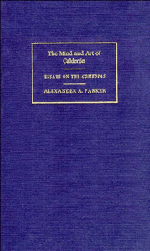Book contents
- Frontmatter
- Contents
- Author's preface
- Editor's preface
- Introduction
- I Stylistic and dramatic craftsmanship
- II From experience to myth
- 6 The father–son conflict
- 7 Segismundo's tower: a Calderonian myth
- 8 Horoscopes and their fulfilment
- 9 Fate and human responsibility (1): the problem
- 10 Fate and human responsibility (2): a dramatic presentation – El mayor monstruo los celos
- III The tensions of social life
- IV The tensions of public life
- V From symbol to myth
- Epilogue
- Notes
- Index
7 - Segismundo's tower: a Calderonian myth
Published online by Cambridge University Press: 05 February 2012
- Frontmatter
- Contents
- Author's preface
- Editor's preface
- Introduction
- I Stylistic and dramatic craftsmanship
- II From experience to myth
- 6 The father–son conflict
- 7 Segismundo's tower: a Calderonian myth
- 8 Horoscopes and their fulfilment
- 9 Fate and human responsibility (1): the problem
- 10 Fate and human responsibility (2): a dramatic presentation – El mayor monstruo los celos
- III The tensions of social life
- IV The tensions of public life
- V From symbol to myth
- Epilogue
- Notes
- Index
Summary
La vida es sueño (1635) clearly marks a new pattern of play in the Calderonian drama, one that can be associated with what Northrop Frye called the ‘mythical mode’ in literature. It is a curious fact, not previously explained satisfactorily, that Segismundo, a fatherless son brought up in a prison and alternating between imprisonment and freedom, becomes not so much a ‘type character’ for Calderón as a ‘type figure’, even an ‘archetypal’ one. This change is effected when a young man or woman, brought up in prison from birth for reasons that he or she cannot fathom, and yearning for the freedom of which he or she, alone in the world of nature, seems to be deprived, is suddenly given freedom and proceeds to exercise it. In calling this a ‘Calderonian Myth’ the intention is not to stress its associations in classical mythology, although it has these; rather is it intended to denote a personal myth, one that Calderón invents for a purpose that has become, with La vida es sueño, very significant for him.
The change of ‘dramatic mode’ is indicated by the fact that while the type figure of the fatherless son is presented in the plays previously under review within a ‘real-life’ situation, and therefore capable of being imagined by the reader, qua action, as ‘realistic’, La vida es sueño presents a non-real situation, in fact a humanly impossible one.
- Type
- Chapter
- Information
- The Mind and Art of CalderónEssays on the Comedias, pp. 86 - 95Publisher: Cambridge University PressPrint publication year: 1989



